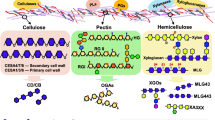Abstract
Pear cell suspension cultures (PCSC) inoculated with virulent strains of the fireblight bacterium,Erwinia amylovora, exhibited massive necrosis within 7 days, whereas avirulentE. amylovora strains and other enterobacteria generally elicited very slight or no necrotic reactions. These results were generally repeated when pear seedlings (1–2 months old) were inoculated with these same bacterial strains. Fractions derived from massively necrotized PCSC were tested for biological activity against healthy PCSC and pear seedling cuttings. Of these fractions, the dialyzable, 70%-ethanol-soluble material—remaining after precipitation by ethanol of high-molecular-weight polysaccharides (“amylovorin”)—exclusively inhibited growth of pear callus, plasmolyzed and disintegrated pear cells in PCSC, and caused some browning of pear callus. Although cuttings of young pear seedlings placed in solutions containing this dialyzable, ethanol-soluble material generally became massively necrotized within 3 days, some residual methodological problems with this bioassay procedure must be solved. These observations suggest that some relatively small molecule(s) formed in PCSC inoculated with virulentE. amylovora can exert antagonistic biological activity against pear tissue and may play a role in the symptomatology characteristic of the fireblight disease.
Similar content being viewed by others
Literature Cited
Agrios, G. N. 1978. Plant pathology, 2nd ed. New York, London: Academic Press.
Aldwinckle, H. S., van der Zwet, T. 1979. Recent progress in breeding for fire blight resistance in apples and pears in North America. EPPO Bulletin9:27–34.
Anderson, A. J. 1978. Isolation from three species ofColleototrichum of glucan-containing polysaccharides that elicit browning and phytoalexin production in bean. Phytopathology68:189–194.
Anderson-Prouty, A. J., Albersheim, P. 1975. Host-pathogen interactions. VIII. Isolation of a pathogen-synthesized fraction rich in glucan that elicits a defense response in the pathogen’s host. Plant Physiology56:286–291.
Ayers, A. R., Ayers, S. B., Goodman, R. N. 1979. Extracellular polysaccharide ofErwinia amylovora: A correlation with virulence. Applied and Environmental Microbiology38:659–666.
Bennett, R. A. 1980. Evidence for two virulence determinants in the fireblight pathogenErwinia amylovora. Journal of General Microbiology116:351–356.
Bennett, R. A., Billing, E. 1978. Capsulation and virulence inErwinia amylovora. Annals of Applied Biology89:41–45.
Bennett, R. A., Billing, E. 1980. Origin of the polysaccharide component of ooze from plants infected withErwinia amylovora. Journal of General Microbiology116:341–349.
Chatterjee, A. K., Starr, M. P. 1972. Genetic transfer of episomic elements amongErwinia species and other enterobacteria: F’lac+. Journal of Bacteriology111:169–176.
Chatterjee, A. K., Starr, M. P. 1973. Gene transmission among strains ofErwinia amylovora. Journal of Bacteriology116:1100–1106.
Chatterjee, A. K., Starr, M. P. 1979. Genetics and physiology of plant pathogenicity inErwinia amylovora, pp. 81–88. In: Station de Pathologie Végétale et Phytobactériologie (eds.), Proceedings of the IVth International Conference on Plant Pathogenic Bacteria [Angers, 1978]. Beaucouzé: Institut National de la Recherche Agronomique.
Chatterjee, A. K., Starr, M. P. 1980. Genetics ofErwinia species. Annual Review of Microbiology34:645–676.
Dische, Z. 1962. Color reaction of carbohydrates, pp. 477–512. In: Whistler, R. L., Wolfrom, M. L. (eds.), Methods in carbohydrate chemistry, vol. 1. New York: Academic Press.
Goodman, R. N., Huang, J.-S., Huang, P.-Y. 1974. Host-specific phytotoxic polysaccharide from apple tissue infected byErwinia amylovora. Science183:1081–1082.
Hildebrand, D. C., Schroth, M. N. 1963. Relation of arbutin-hydroquinone in pear blossoms to invasion byE. amylovora. Nature197:513.
Hildebrand, E. M. 1954. Relative stability of fire blight bacteria. Phytopathology44:192–197.
Hsu, S.-T., Goodman, R. N. 1978. Production of a host-specific, wilt-inducing toxin in apple cell suspension cultures inoculated withErwinia amylovora. Phytopathology68:351–354.
Kirkham, D. S. 1957. Studies of the significance of polyphenolic host metabolites in the nutrition ofVenturia inaequalis andVenturia pirina. Journal of General Microbiology17:120–134.
Lakso, J. U., Starr, M. P. 1970. Comparative injuriousness to plants ofErwinia spp. and other enterobacteria from plants and animals. Journal of Applied Bacteriology33:692–707.
Pugashetti, B. K., Chatterjee, A. K., Starr, M. P. 1978. Isolation and characterization of Hfr strains ofErwinia amylovora. Canadian Journal of Microbiology24:448–454.
Pugashetti, B. K., Starr, M. P. 1975. Conjugational transfer of genes determining plant virulence inErwinia amylovora. Journal of Bacteriology122:485–491.
Schenk, R. U., Hildebrandt, A. C. 1972. Medium and techniques for induction and growth of monocotyledonous and dicotyledonous plant cell cultures. Canadian Journal of Botany50:199–204.
Sjulin, T. M., Beer, S. V. 1978. Mechanism of wilt induction by amylovorin in cotoneaster shoots and its relation to wilting of shoots infected byErwinia amylovora. Phytopathology68:89–94.
Strobel, G. A. 1977. Bacterial phytotoxins. Annual Review of Microbiology31:205–224.
Author information
Authors and Affiliations
Rights and permissions
About this article
Cite this article
Buchanan, G.E., Starr, M.P. Phytotoxic material from associations betweenErwinia amylovora and pear tissue culture: Possible role in necrotic symptomatology of fireblight disease. Current Microbiology 4, 63–68 (1980). https://doi.org/10.1007/BF02602894
Issue Date:
DOI: https://doi.org/10.1007/BF02602894




